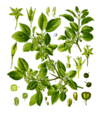List of invasive plant species in Pennsylvania facts for kids
Plants from all over the world have been brought to the US state of Pennsylvania over the last 400 years. Many of these plants have become invasive species. This means they spread quickly and aggressively, taking over areas and making it hard for native plants (the ones that naturally grow there) to survive. Invasive plants can harm the environment by pushing out native species and changing the natural balance of ecosystems.
Contents
What Are Invasive Plants?
Invasive plants are like uninvited guests that don't know when to leave! They are plants that are not originally from Pennsylvania but have been introduced, often by accident or because people thought they would be useful. Once they arrive, they grow very fast, spread easily, and can outcompete the plants that are supposed to be there. This can cause big problems for local wildlife and the environment.
The Pennsylvania Department of Conservation and Natural Resources (DCNR) helps keep track of these unwanted plants. They sort invasive species into three groups based on how serious the threat is. This helps them decide which plants need the most attention to control their spread.
Common Invasive Plants in Pennsylvania
There are many different types of invasive plants in Pennsylvania. Here are a few examples of common ones you might see:
Trees and Shrubs
- Norway Maple (Acer platanoides): This tree was brought over from Europe and Asia. It grows very quickly and creates a lot of shade, which stops native plants from growing underneath it.
- Tree of Heaven (Ailanthus altissima): Originally from China, this tree is known for growing almost anywhere, even in cracks in sidewalks! It releases chemicals into the soil that can prevent other plants from growing nearby.
- Japanese Barberry (Berberis thunbergii): This thorny shrub from Japan is often planted in gardens. However, it spreads easily into forests, forming dense thickets that crowd out native plants and can even provide shelter for ticks.
- Japanese Honeysuckle (Lonicera japonica): This vine from East Asia can climb over and smother other plants, blocking their sunlight and making it hard for them to grow.
- Multiflora Rose (Rosa multiflora): Another plant brought for gardens, this rose from East Asia has sharp thorns and forms dense, thorny bushes that are hard to walk through and can take over pastures and woodlands.
Vines and Groundcovers
- Garlic Mustard (Alliaria petiolata): This plant from Europe smells like garlic when crushed. It spreads very fast in forests, covering the ground and stopping native wildflowers and tree seedlings from growing.
- Japanese Knotweed (Reynoutria japonica): This plant from East Asia has strong, bamboo-like stems. It grows very quickly, especially along rivers and roads, and can even damage foundations and pavement.
- Kudzu (Pueraria): Known as "the vine that ate the South," Kudzu is a fast-growing vine from Asia. It can completely cover trees and buildings, blocking out sunlight and killing the plants underneath.
Other Invasive Plants
- Giant Hogweed (Heracleum mantegazzianum): This is a very dangerous plant from Asia. Its sap can cause severe burns and blisters if it touches your skin, especially when exposed to sunlight. It's important to never touch this plant!
- Common Reed (Phragmites australis): This tall grass grows in wet areas like wetlands and ditches. It forms very dense stands that push out native wetland plants and reduce habitat for birds and other wildlife.
Why Are Invasive Plants a Problem?
Invasive plants cause several problems for Pennsylvania's natural areas:
- They harm native plants: Invasive species grow faster and spread more easily, taking up space, water, and sunlight that native plants need. This can lead to native plants dying off.
- They hurt wildlife: Many animals rely on native plants for food and shelter. When invasive plants take over, animals might not find the food they need, or their habitats can be destroyed.
- They change ecosystems: Invasive plants can change the soil, water, and even how wildfires spread, making it harder for the natural environment to function properly.
- They can be costly: It takes a lot of money and effort to try and remove invasive plants and restore natural areas.
What Can You Do to Help?
Even kids can help fight invasive plants!
- Learn to identify them: Knowing what invasive plants look like is the first step.
- Don't plant them: Choose native plants for your garden or yard. Ask at nurseries if a plant is native or invasive.
- Clean your gear: If you go hiking or biking, clean your shoes, clothes, and bike to avoid spreading seeds to new areas.
- Volunteer: Look for local groups that organize invasive plant removal events. It's a great way to get outdoors and make a difference!
- Report them: If you see a dangerous plant like Giant Hogweed, report it to your local conservation department.
See also
- Invasive species in the United States
Images for kids























